
Diagram of Revision 1 system courtesy of Magnaflow
Note the bend of the intake info the muffler. R2 is closer to 180° and parallel to the muffler.
2008
Subaru WRX STi
Magnaflow Cat-Cab Exhaust System
System
The Magnaflow cat-back exhaust # 16824
Material: 100% Stainless
Steel
Tubing O.D. Size: 3in.
System Type: Cat-Back
TIP O.D. Size: 4in.
TIP Quantity: 4
Single/Dual: Dual Outlet
Exit Position: Rear Exit
Updated Info:
After some initial tip allignment and fitment issues, Magnaflow haulted production around mid July of 2008. A new design was released toward the first of August, 2008. The two designs have become unofficially know as Revision 1 and Revision 2 to simplify discussions. When ordering a system (either directly from Magnaflow or from one of their dealers) be sure to specify that you want the revised system (manufactured in August of 2008 or later). Magnaflow is honoring all requests for replacements. If you bought from a local dealer, it's a simple thing to go and ask for a replacement. A mail order means you're often saddled with the cost of return shipping (either to Magnaflow or, in some cases to your selling dealer and then also from them to Magnaflow). Due to the weight of the kit, this can run around $100 (or more). IMO the system is still worth it (being essentially a beta tester) it's not nearly the outstanding price as it was before all the additional cost and hassle of the swap. Do yourself a favor and insist on the Revision 2.

Diagram of Revision 1 system courtesy of Magnaflow
Note the bend of the intake info the muffler. R2 is closer to 180° and parallel
to the muffler.
The system uses a multi-piece, slip joint design compared to the OEM, 1 piece design. It is assumed that the main reason for this design choice was to simplify shipping.
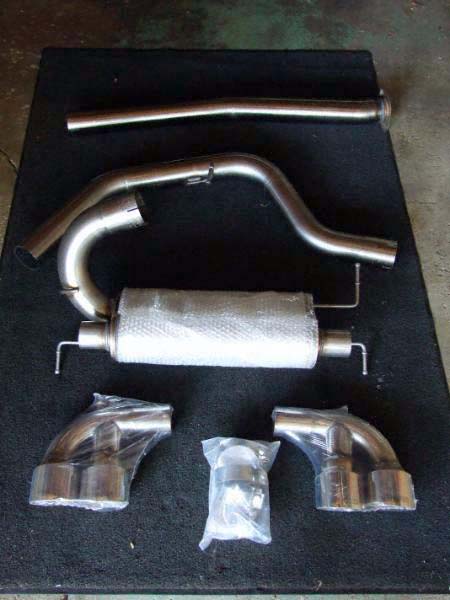
Revision 1 kit
Photo Courtesy Spaceman
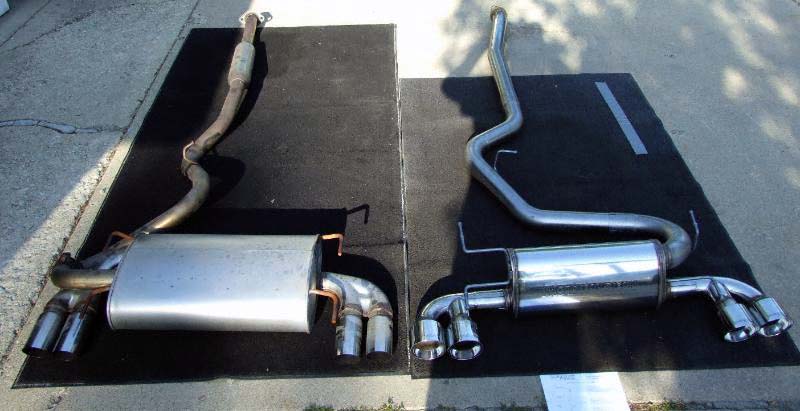
Left=OEM, Right=Magnaflow R1
Photo Courtesy Spaceman
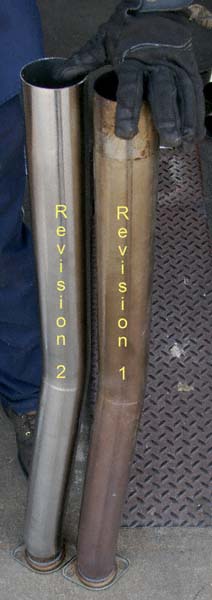
Front Pipe Comparisons
There are no noticable changes
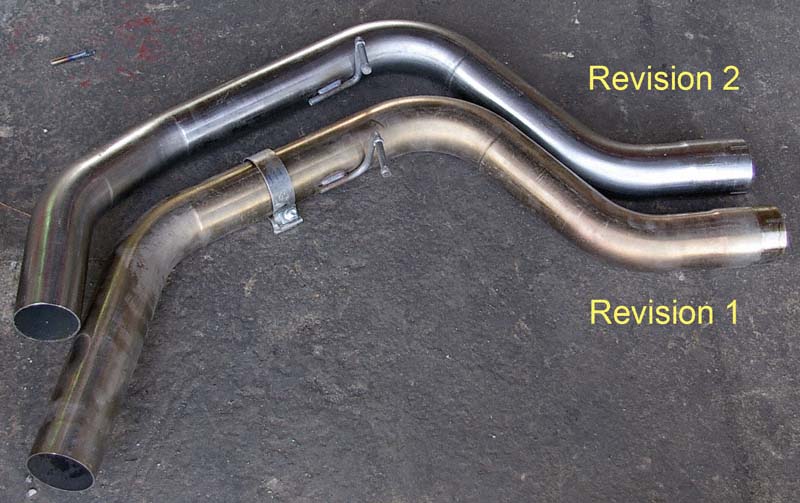
Mid Pipe Comparisons
Note the differences to the left where the pipe mates to the muffler intake.
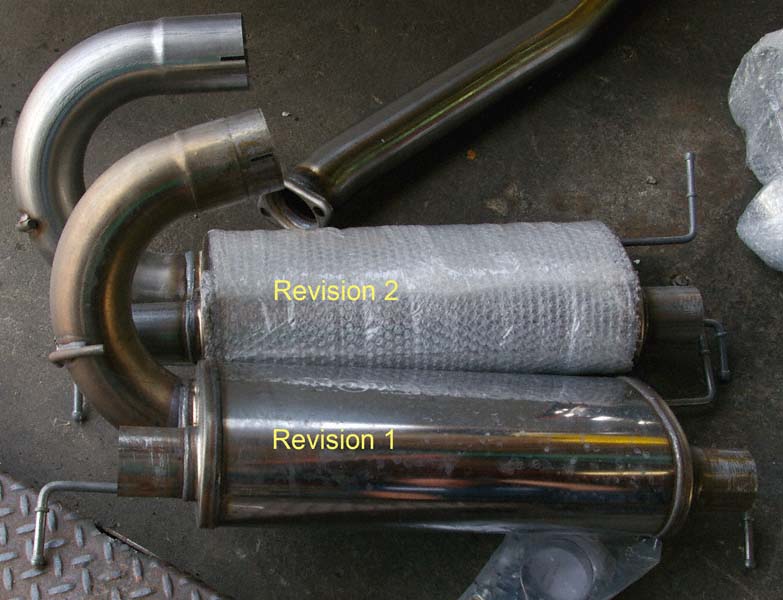
Muffler Comparisons
Note the differences to the bend of intake pipes & hangars
The kit arrived, well packed, and we scheduled a visit to a friend's "under car specialist" shop for the installation. Slip joint designs tend to require that you loose-fit the system and then "walk the line" several times while making adjustments prior to tightening everything down. The lifts at Jerry's shop make this work a snap compared to crawling around on our driveway in the 100+° summer heat with the car on jack stands. This is not a project beyond the ability of a moderately-skilled home mechanic with patience and cooler temperatures.
Appearance
The look between the OEM and the Magnaflow systems are (in our opinion) dramatic. The pipes are all 3" diameter while the tips are a 4", dual wall design.
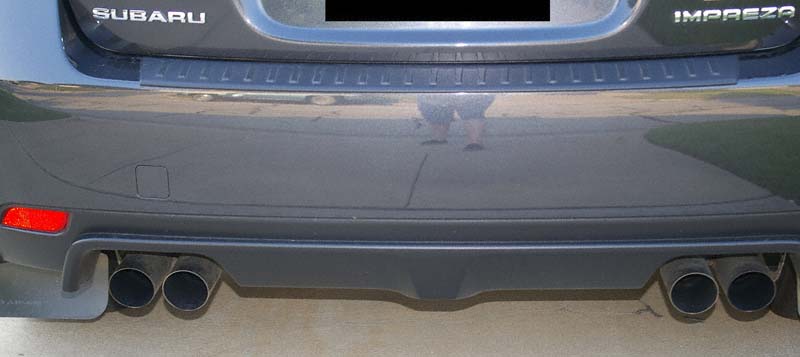
OEM Exhaust

Magnaflow R1 Exhaust
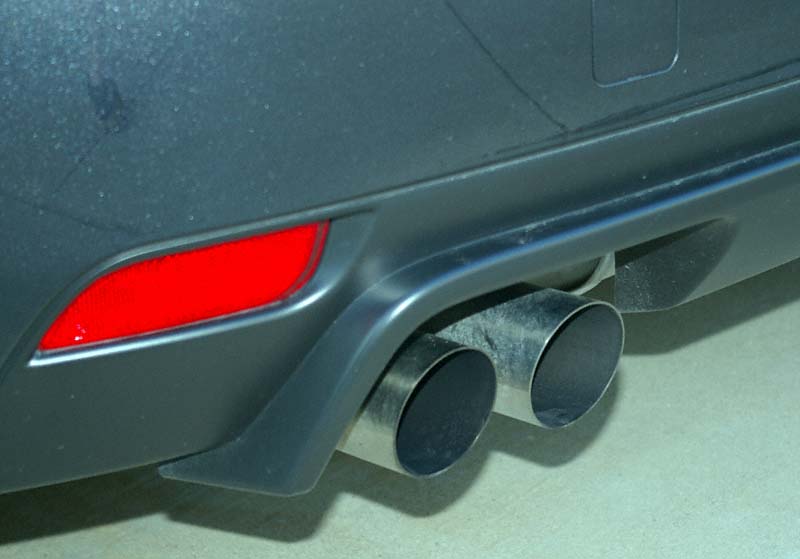
OEM Exhaust
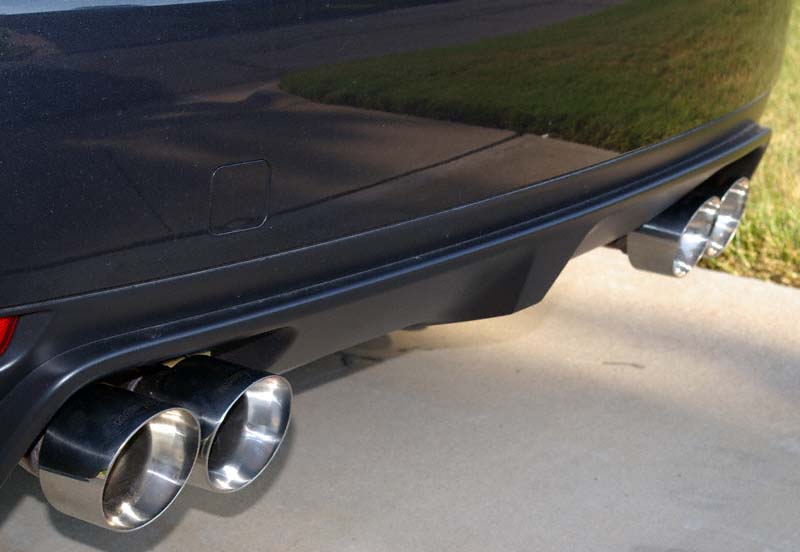
Magnaflow R1 Exhaust

Magnaflow R1 Tip Allignment
Note how the left tips extend farther than the right
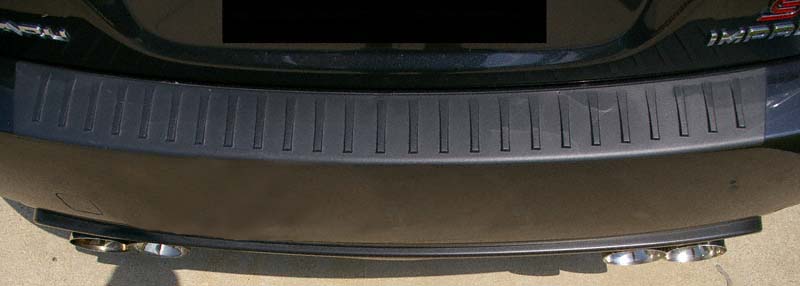
Magnaflow R2 Tip Allignment
Note how the tips extend equally. The tips didn't change. The muffler is now
squared to the back of the car.
The left/inner tip isn't bent, it's a trick of the lighting
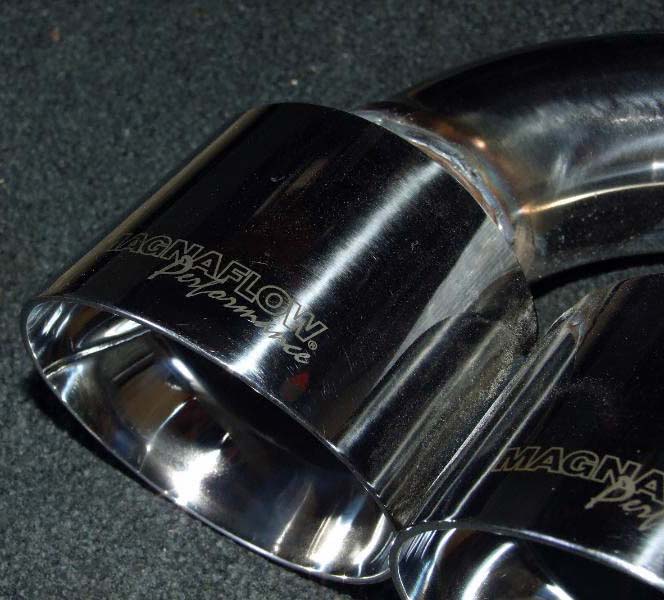
Closeup of Tip & Welds
These remain unchanged between Revisions
Photo Courtesy Spaceman
Sound
Sound samples were taken using an Archos Jukebox Recorder 20 and a RadioShack 33-3038 microphone. In the audio samples you might hear some artifacts that have nothing to do with the source (exhaust) sounds. These include the artifacts from the Archos Recorder as well as some nearby construction and/or birds chirping. Additionally, a RadioShack 33-2055 Sound Level Meter was used to take sound level readings in both the A-Weight (dBA) and C-Weight (dBC). dBA is the typical sampling method used for roadway and environmental noise analysis. It's also the weighting used by various transportation departments when maximum legal sound levels are established for traffic codes. As such, the dBA numbers are the ones to watch when concerned about compliance with noise ordinances. dBC numbers are provided for additional information. The sound level readings should be used for loudness comparisons because each audio sample has had the volume level adjusted to make it easier to compare the tones of each exhaust system. Since dBC tests lower frequencies than dBA does (32Hz vs 500Hz), the higher dBC readings reflect the deeper exhaust tone of the Magnaflow as compared to the OEM STi exhaust.
Each measurement point was chosen for a reason. Idle and rev are self-evident. 3000 RPM was chosen because it's the speed the motor is running when on the highway doing about 70 MPH. 3200 RPM was chosen because it's "half red line"; a speed chosen by entities like the Society of Automotive Engineers (SAE) in their J1287 standard and by our personal favorite, The Iron Butt Association. The 5000 RPM stationary and pass tests were chosen as being a decently-agressive speed without risk of hitting the rev limiter while testing. Only sound samples were taken at 5000 RPM and Rev (no dBA or dBC readings were made) since these are outside of any standaridized testing requirements. They are sampled simply for the reader and because we thought they sounded good. (Reason enough for us. Right?)
All measurements were taken directly behind (in line with) and 20" from the exhaust tip of each system. This is also an SAE J1287 standard. The STi was in "S" mode during all testing.
OEM Exhaust (3,500 miles) |
Magnaflow Cat-Back Exhaust (100 miles) |
Idle (900 RPM) |
Idle (900 RPM) dBA 80; dBC: 94 Audio (71Kb) |
| 3000 RPM dBA: 73; dBC: 91 Audio (76Kb) |
3000 RPM dBA: 89; dBC: 104 Audio (76Kb) |
| 3200 RPM (Half Redline) dBA: 74; dBC: 92 Audio (58Kb) |
3200 RPM (Half Redline) dBA: 91; dBC: 105 Audio (58Kb) |
5000 RPM |
5000 RPM |
5000 RPM Pass |
5000 RPM Pass dBA: N/A; dBC: N/A Audio (45Kb) |
| Rev dBA: N/A; dBC: N/A Audio (103Kb) |
Rev dBA: N/A; dBC: N/A Audio (107Kb) |
Personal Experience
Magnaflow came out with their single-muffler, dual outlet, quad tip exhaust for the 2008 STi in the summer of 2008. This page discusses their initial product (which we'll call "revision 1").
This is not an installation guide but, instead of an evaluation of the final product based on objective sound samples and sound level readings, as well as subjective personal opinion. Objective material was given above. This section deals with the subjective items. It's hoped that this information will be useful to anyone considering exhaust options for the 2008 STi.
Magnaflow's cat-back exhaust (# 16824) has an MSRP of $721.95. In a world of supra-$1000 products from other vendors, this would have caught our attention. When word got out on the STi forums that there were dealers selling it for just over $400 it got everyone's attention. At first, a brave soul or two tested the waters and found it was good. Within two weeks, as more people dove in, prices rose and in-stock quantities dropped. It wasn't long before Magnaflow was completely out of Revision 1 stock.
Shortly after the installations began reports of fitment, alignment, and quality control issues started showing up. Talks with our installation shop revealed that most issues were typical of "bolt on" solutions that make use of slip joint designs like the Magnaflow system does. The shop we used reported that the kit we got was "better than usual". They explaining to us how a number of other brands require much more adjustment. In our case, the primary adjustment was due to our after market Cusco rear subframe brace. However, not all forum reports could be dismissed as overly-high expectations. A few were actual issues with quality control while one or two items of concern were systemic in the design of Revision 1.
The two main, consistent issues were:
1. The uneven extension of the tips where the left (driver's side) tip-pair extended out farther than the right (passenger side) tip-pair. This was universal.
2. Exhaust whistling as a result of how the secondary (inner) tip or each pair branched off a simple hole cut in the primary (external) tip's pipe in each pair (right and left). In some cases, the exhaust gases blew over the hole in the primary pipe like a child blowing over the neck of a soda bottle. Under heavy acceleration, some owners could hear their pipes whistling. This was not universal.
At this time (August 3, 2008) there are reports that Magnaflow is aware of the issues of Revision 1. We contacted our selling dealer and Magnaflow; providing them with photographs, audio, and written details of our kit after it was installed by and authorized installer. In our case, the main issue is the uneven exhaust tips. Others have reported that Magnaflow is working on a Revision 2 that will make appropriate corrections. It remains to be seen what, if anything, will be done for those who purchased Revision 1.
We had a Magnaflow dual cat-back system on our 1996 GMC truck and were pleased with its service for the remaining 5 years and 60,000 miles that we owned the truck. After 2 weeks living with their cat-back system for the STi, we are generally pleased and look for a resolution to the uneven tip length issue. The sound has a nice, low growl that causes some droning in the passenger compartment but nothing extreme or anoying.
All-in-all we are pleased with our purchase. If Magnaflow offers a reasonable (read no-cost) method of resolving our problem with the different length tips, then we'll be very happy campers.
For those who have stuck with us this long, here's the video we created.
(C) 1995-Present Mark Johnson, All Rights Reserved